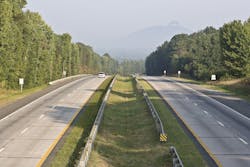Herbicide helps grass thrive along Mississippi roads
Weeds and other undesirable vegetation like to make their home along roadsides, but their presence can inhibit motorist security and line of sight as well as promote the spread of invasive species onto adjacent properties. What’s more, excessive vegetation can damage roadbeds by creating erosion, potholes and flooding due to improper drainage off the surface.
When controlling these weeds with herbicides, it is important to do so without injuring desirable vegetation, especially grasses—a point not lost on Gary Porter, vegetation manager for the Mississippi Department of Transportation.
“Protecting grass from injury with our herbicide treatments is so important because of the potential negative effects associated with poor grass stand density—especially erosion,” Porter said. “Many of our roads are in close proximity to the Mississippi River, and there are a lot of loess bluffs in the area, meaning a good rainstorm can cause major washouts along our roads. A good, dense grass stand helps us avoid having crews constantly fixing these washes.”
A thriving grass stand is crucial when it comes to preventing erosion along roadsides, as it acts as a deterrent to rain and other factors contributing to erosion. But roadside vegetation managers need to be aware of all the benefits of keeping grasses healthy and thriving along roadsides.
A healthy grass stand also serves as a natural weed barrier. If grass density is reduced through injury or other causes, weeds will begin to germinate and crowd out what grass remains. Although weeds most likely will be present even in the thickest stands of grass, when grass density is lowered, aesthetics, motorist security and the economics of maintaining the roadside usually follow suit.
“Along our roadsides, we have issues with cogongrass, thistles and several other problem species all trying to crowd out our bahiagrass and bermudagrass,” Porter said. “We use several different herbicides in our program, but in real tough areas, we use a treatment of 5 to 7 oz of Milestone specialty herbicide. It has the broadest spectrum of weed control, and it also does very well on black locust, mimosa and several woody vines, with minimal grass injury.”
Milestone specialty herbicide can be used as a broadcast application on bahiagrass roadsides and is compatible with other products with bahiagrass labels. In addition, the herbicide can be applied year-round in bermudagrass roadsides without concerns of injury and is labeled for use on most cool- and warm-season perennial grasses.
To meet the challenge of keeping America’s roadsides secure and beautiful, it is important that vegetation managers arm themselves with the proper knowledge and training, as well as use the right herbicide products.
It also is important to understand and promote the benefits of a healthy roadside grass stand, as its presence will go a long way toward making roadsides both secure and beautiful.
Wright is an IVM Specialist for Dow AgroSciences.
Dow AgroSciences LLC
Fax: 800-905-7326
Phone: 800-263-1196
